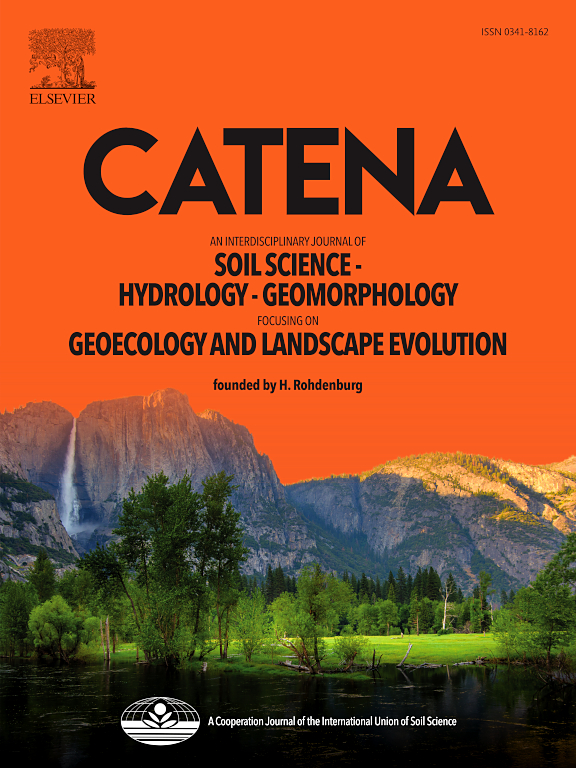An experimental study on the erosion mitigation impact of biological soil crusts in Pisha sandstone area
IF 5.4
1区 农林科学
Q1 GEOSCIENCES, MULTIDISCIPLINARY
引用次数: 0
Abstract
Effective erosion mitigation in the Pisha sandstone region is crucial for soil and water conservation in the Yellow River Basin, yet existing vegetation measures are inadequate in water-limited environments. This study examines the application of drought-tolerant biological soil crusts (biocrusts) for erosion control on sandstone slopes and evaluates their erosion-reducing effects under varying coverage and slope conditions through controlled artificial rainfall experiments. Key findings include: (1) biocrusts coverage demonstrated a linear relationship with initial runoff generation time and an exponential relationship with stable runoff generation time. On average, biocrusts delayed initial runoff generation by 396.32 % and extended stable runoff generation time by 153.93 %, thereby increasing the threshold for both initial and stable runoff generation on Pisha-sandstone surfaces. (2) biocrusts reduced runoff volume by an average of 23.89 %, enhanced infiltration volume by 69.19 %, decreased sediment yield by 64.24 %, and lowered the soil erosion modulus by 68.98 %. These results indicated significant promotion of water infiltration and reduction of water erosion. Both effects were positively influenced by coverage and negatively impacted by slope gradient. A critical slope angle of 15° and a critical coverage of 60 % were identified. When the slope was gentle (S ≤ 15°), increased coverage predominantly contributed positively. Conversely, when the slope was steep (S > 15°), the negative impact of slope predominated, diminishing the positive effect of biocrusts. Additionally, when coverage reached or exceeded 60 %, further increaseing in coverage accelerated the enhancement of infiltration and erosion reduction. Below this threshold, the rate of improvement gradually diminished with increasing coverage. (3) The structural equation model further elucidated that biocrusts mitigate erosion by enhancing the coverage, thereby reducing runoff velocity and modifying the runoff regime. This mechanism effectively dissipates runoff energy, leading to a decreased soil detachment rate and alleviation of soil erosion. Additionally, the relationship between runoff energy and soil detachment rate follows a power function curve, providing an effective method for predicting erosion in Pisha sandstone area. Consequently, biological soil crust technology shows considerable potential for preventing water erosion damage on Pisha sandstone slopes across various gradients.
求助全文
约1分钟内获得全文
求助全文
来源期刊

Catena
环境科学-地球科学综合
CiteScore
10.50
自引率
9.70%
发文量
816
审稿时长
54 days
期刊介绍:
Catena publishes papers describing original field and laboratory investigations and reviews on geoecology and landscape evolution with emphasis on interdisciplinary aspects of soil science, hydrology and geomorphology. It aims to disseminate new knowledge and foster better understanding of the physical environment, of evolutionary sequences that have resulted in past and current landscapes, and of the natural processes that are likely to determine the fate of our terrestrial environment.
Papers within any one of the above topics are welcome provided they are of sufficiently wide interest and relevance.
 求助内容:
求助内容: 应助结果提醒方式:
应助结果提醒方式:


